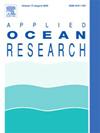Robust control method for automatic berthing of unmanned ships based on weight optimal loop shaping
IF 4.4
2区 工程技术
Q1 ENGINEERING, OCEAN
引用次数: 0
Abstract
Automatic berthing is one of the key functions for autonomous navigation of unmanned ships, and it is an important technology that assists and ensures ships complete their voyage tasks. To enhance the robustness, scenario universality, and disturbance resistance of automatic berthing technology, an automatic berthing method based on weight optimal loop shaping is proposed in this paper. Firstly, to enhance the robust stability margins of the berthing controller, the concept of weight optimization is introduced to transform the frequency-domain dependent weight optimization into an optimization problem with a finite number of frequency-domain independent constraints. Secondly, to improve the continuity and scenario universality of the algorithm, a transformation model between berth and earth coordinates is constructed using Bézier curves, and a forward Euler signal tracking method is introduced to provide a differentiable reference trajectory for the control system. Finally, the proposed method is validated through the construction of various berthing scenarios. The validation results indicate that the proposed method can achieve automatic berthing in different scenarios with better stability and disturbance resistance, and a theoretical reference is provided for the development of autonomous berthing technology for unmanned ships.
基于重量最优回路成形的无人船舶自动靠泊鲁棒控制方法
自动靠泊是无人船舶自主航行的关键功能之一,是辅助和保证船舶完成航行任务的重要技术。为了提高自动靠泊技术的鲁棒性、场景通用性和抗干扰性,提出了一种基于权重最优回路整形的自动靠泊方法。首先,为了提高靠泊控制器的鲁棒稳定裕度,引入权值优化的概念,将频域相关权值优化问题转化为具有有限个频域无关约束的优化问题;其次,为了提高算法的连续性和场景通用性,利用bsamzier曲线构建了泊位与地面坐标的转换模型,并引入了正演欧拉信号跟踪方法,为控制系统提供了可微参考轨迹;最后,通过构建各种靠泊场景对所提方法进行了验证。验证结果表明,所提方法能在不同场景下实现自动靠泊,且具有较好的稳定性和抗干扰性,为无人船舶自主靠泊技术的发展提供理论参考。
本文章由计算机程序翻译,如有差异,请以英文原文为准。
求助全文
约1分钟内获得全文
求助全文
来源期刊

Applied Ocean Research
地学-工程:大洋
CiteScore
8.70
自引率
7.00%
发文量
316
审稿时长
59 days
期刊介绍:
The aim of Applied Ocean Research is to encourage the submission of papers that advance the state of knowledge in a range of topics relevant to ocean engineering.
 求助内容:
求助内容: 应助结果提醒方式:
应助结果提醒方式:


